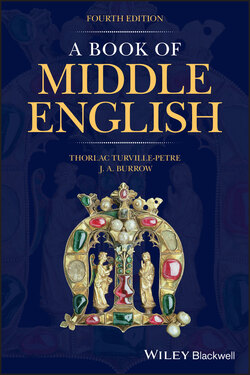Читать книгу A Book of Middle English - J. A. Burrow - Страница 58
5.3.3 Dative
ОглавлениеThe most common use of the dative case is with prepositions such as to, mid and bi. Compare þi song (nominative) with bi mine songe (dative), 2/220 and 46. After the dative singular ‐e ending was lost from nouns (see 4.2.3), the dative became indistinguishable from other cases without inflexion.
The dative was used for the indirect object: hi hadden him manred maked, ‘they had done him homage’, 1/11. Without a distinct form for the dative, however, the indirect object had to be distinguished from the direct object by word‐order or the use of to, as it is in Modern English: seist me boþe tone and schame, ‘say to me both insult and shame’, 2/50; ʒeve hem benes, ‘give them beans’, 7b/177.
Some adjectives, such as loþ and lef, have a dative object: loþ smale foʒle, ‘hateful to small birds’, 2/277; lof him were niʒtingale, ‘nightingales were dear to him’, 2/203.
The Old English use of a dative pronoun to indicate possession is still found, particularly in early texts: him bræcon alle þe limes, ‘all his limbs broke’, 1/28; freshe hym þe face, ‘his face unblemished’, 11/89.
The adverbial dative of the type ludere stæfne, ‘with a loud voice’, 3/30, is rare even in early texts, and is superseded entirely by prepositional phrases; so mid fulle dreme and lude stefne, 2/314.
A pleonastic dative pronoun me, the ‘ethic dative’, is a characteristic feature of the Gawain poems: he swenges me þys swete schip, ‘it turns this fine ship’, 8/108; also made me þane unto þis tree, ‘fastened then to this tree’, 15/42. This kind of dative expresses the speaker’s interest in the fact stated.
For other uses of the dative with verbs, see 5.4.5 (reflexive pronouns), 5.6.8 (impersonal verbs) and 5.6.9 (verbs of motion).
